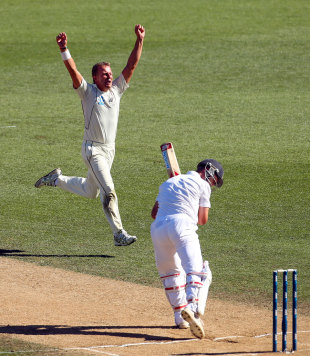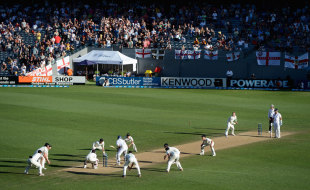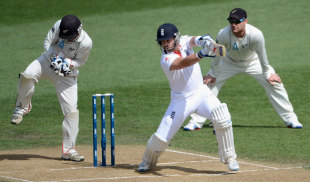New Zealand v England, 2012-13
Derek Pringle
Twenty20 internationals (3): New Zealand 1, England 2
One-day internationals (3): New Zealand 1, England 2
Test matches (3): New Zealand 0, England 0

|
|||
|
Related Links
Series/Tournaments:
England tour of New Zealand
Teams:
England
| New Zealand
|
|||
On England's previous visit to New Zealand, in 2007-08, it had been possible to discern the makings of the team that would top the Test rankings a little over three years later. This time, despite a pair of 2-1 wins in the Twenty20 and one-day series, there were few such portents. Instead, the abiding image was of England hanging on for dear life to secure a draw in the Third Test at Auckland, and with it an underwhelming share of a series most onlookers had expected them to win with room to spare.
Such expectations had less to do with arrogance and more with the form book. While England had confirmed their status as the world's second-best Test team behind South Africa with a historic win in India before Christmas, the New Zealanders were languishing in eighth, without a series victory over serious opposition since 2006. They had lost seven of their previous eight Tests - three by an innings, one by ten wickets, one by nine. And their dressing-room looked close to disarray following the Ross Taylor-Mike Hesson debacle. Quite simply, they seemed there for the taking.
Instead, inspired by the innovative captaincy and quicksilver batting of Brendon McCullum, they emerged with their best Test result since brushing aside India's great batting line-up at home a decade earlier. McCullum himself repeatedly confounded England's bowlers, and across the formats made 10, 74, 26, 69 not out, 74, 79, 74, 69, 38 and 67 not out - a total of 580 runs from 496 balls, with 24 sixes. England dropped short too often, but this was still an astonishing performance from a player saddled with the burden of replacing the popular Taylor.
Despite McCullum's excellence, England had been the superior side in the two limited-overs series, even if they were taken to a decider in both; the ten wicket win in the Twenty20 finale at Wellington's Westpac Stadium was especially brutal. But their Test cricket failed to ignite. With the bat, only the outstanding Matt Prior - whose double of 73 and 110 not out staved off defeat at Auckland - Jonathan Trott and Nick Compton averaged over 40; with the ball, not one member of the frontline attack averaged under 30, though Stuart Broad did return to form during the Second Test at Wellington. A knee injury to Kevin Pietersen, which ruled him out of the Third Test, compounded the sense of frustration.
The time-honoured search for positives did not take long. Having made a steady but unspectacular start to his England career in India as Andrew Strauss's replacement, Compton now scored hundreds in the first two Tests, and earned the priceless commodity of knowing he could perform at the highest level. But Alastair Cook fell away after a second-innings hundred at Dunedin, Pietersen flickered briefly, and Ian Bell - as he had done in India - redeemed himself only at the last, paving the way for Prior's last-day heroics at Auckland with a studious 75. For Joe Root, a sparkling performance in the one-day series was followed by a reminder of cricket's capacity to act as a leveller: three Tests brought him a top score of 45.
England could hardly blame the scheduling - an eminently sensible programme comprising three Twenty20s, three one-day internationals and three Tests, all fitted into two months. If there was a flaw, it was that they had only one warm-up match for the Tests, though team director Andy Flower claimed there was simply not enough time to squeeze in a second. Flower had long advocated the virtues of rest and rotation: Pietersen, James Anderson and Graeme Swann had all missed matches following the Test series in India. But Flower's case was hardly strengthened by what transpired. After bowling shakily in the one-day internationals and the four-day warm-up game at Queenstown, Swann returned home just before the Tests for an operation on his right elbow. A fortnight later, Pietersen followed him, having limped through two Tests with a sore right knee. Anderson, who at least managed to see out his leg of the tour, bowled more Test overs than any of the English seamers but, for reasons nobody could quite pinpoint, lacked his usual threat in conditions most felt would suit him.
Perhaps the truth in Anderson's case applied just as well to the whole team: after the stirring win in India, it was always going to be difficult to produce the same intensity against New Zealand. In the land of the long white cloud, cricket has rarely emerged from rugby's all black shadow. To say the tour was low-key was as readily apparent in Wellington as it was in faraway London.

|
|||
undefined local interest was mixed: crowds for the limited-overs internationals mostly exceeded 10,000 (and nearly 24,000 turned up for the Auckland Twenty20), but the Test attendances were modest, despite a large contingent of English fans. This was unfortunate, for the New Zealanders needed to impress their own fans after the humiliation in South Africa two months earlier, when they lost both Tests by an innings after totals of 45 and 121 - itself a recovery from 62 for nine.
That drubbing, the unceremonious removal of Taylor as captain in December following the tour of Sri Lanka, and his subsequent replacement by McCullum, made this a pivotal moment for the Test team's public standing. Taylor opted out of that ill-fated tour of South Africa but, after a period of reflection, was now reselected. There was inevitable speculation about the dynamics of a dressing-room containing him, McCullum and Hesson, the coach, but Taylor's return seemed to settle his team-mates. And the warm ovations he received from sympathetic crowds during the limited-overs games were a memorable feature of the early part of the tour. Few innings were better received than his one-day century at Napier.
The pitches during the Twenty20 and 50-over series - especially the dropins at Auckland and Wellington - had been quick and bouncy. But the Test strips were toned down to counter what, on paper at least, was England's superior pace attack. In the event, New Zealand's trio of Trent Boult, Tim Southee and Neil Wagner outbowled Anderson, Broad and Steven Finn in two of the three Tests, finding swing where England could find only straight lines.
Monty Panesar toiled for scant reward after being thrust into the First Test at short notice because of Swann's sudden departure. Having sat one of the modules for his Masters degree in international sports management just three days before that game, Panesar may not have been expecting to play. He bowled accordingly, and finished the series with five wickets at 70 - his worst average in a series in which he had played more than one Test.
Finn's new shorter run-up served him well during the one-dayers, but in the Tests he failed to find consistency - or indeed menace. Missing, too, was an ability to take the ball away from the right-hander. His seven wickets in the final Test were consolation rather than compensation, and he may have been distracted by his efforts to cure his habit of striking the stumps with his trailing knee. A marker, placed just behind the back crease, helped him jump wider. But while he knocked into the stumps less often, it was hardly ideal that he was not fully focused on events at the other end. In the event, his main contribution came with the bat: a stoical nightwatchman's 56, compiled with one of Pietersen's spare blades, helped rescue the First Test at Dunedin.
That knock, following hundreds from Cook and Compton, limited the damage done by England's calamitous first-innings 167. Amid a flurry of illchosen, sloppily executed shots, they succumbed in 55 overs, gifting four wicket hauls to Wagner and the debutant left-arm spinner, Bruce Martin. But the warning signs had been there during England's defeat by a New Zealand XI at Queenstown - their first loss in a first-class tour match for seven years.
With its adventure sports and heady mountain air, Queenstown is regarded as the adrenalin capital of the world, and England's players were keen to get stuck in, many partaking of the canyon swing - but not the famous bungee jump, from which they were banned. Flower even called a team meeting on top of The Remarkables mountain range - a gathering that, at 7,500 feet, required the use of four helicopters.
The extent of England's first-innings failure at Dunedin was brought into even sharper focus when New Zealand replied with 460 for nine, including 171 from debutant Hamish Rutherford. That served only to heighten the opprobrium aimed at England, with Geoff Boycott sniping at the "holiday camp" atmosphere of the preparations. Flower forcefully rejected the claim, arguing that players could not be expected to spend such long periods away from home without recourse to a spot of recreation. If criticism was to be levelled, he argued, it was at England's habit of making a poor start to overseas Test series. Discounting victory over Bangladesh in 2009-10, they needed to go back to Port Elizabeth in 2004-05 for a win in the First Test of a series abroad.
The Basin Reserve, venue for the Second Test, is a proper cricket ground - it shares its space with no other sport - and Cook's team responded with some proper cricket. Compton scored his second hundred in two games, while Trott consolidated his reputation for quiet reliability with his ninth Test century. Pietersen and Prior also weighed in, and Broad claimed six for 51 as New Zealand - with heavy rain forecast over the final two days - were made to follow on.

|
|||
But the negativity that occasionally blighted the reign of Strauss now became evident in Cook's captaincy. The most glaring example came when New Zealand slumped to 89 for five in the first innings, at which point Cook gave Anderson only two slips and a gully as he bowled to B-J. Watling. Sure enough, an edge soon flew through third slip at catchable height - and Watling proceeded to add a vital 100 with McCullum.
That left the teams with all to play for in Auckland, a quirky venue at which England had already chalked up two victories during the tour. Another fillip came in the knowledge that, when both the Twenty20 and one-day series had come down to a decider, England had twice raised their game. Instead, it was the New Zealanders who found the players to make inspired interventions amid the toytown dimensions of Eden Park, where the straight boundaries were barely 65 yards long. Of the 17 sixes in the Test, they hit 16. And the lanky Peter Fulton, making a mockery of his average of 23, launched eight of them - one more than he had managed in his previous 12 Tests in total - while compiling a hundred in each innings.
There was a feeling that McCullum had enjoyed a psychological edge over Cook ever since mischievously likening him to Don Bradman in the build-up to the Second Test. Another of his strategies was to tell the media, the day before each Test, what he would do if he won the toss. In Auckland, he said he would bowl, as he had done at Dunedin and Wellington, a decision Cook himself went on to make, with disastrous consequences: at stumps on the first day, New Zealand had reached 250 for one. For England, it was sobering stuff.
From then on, they were fighting to save the series, and eventually entered the last day four wickets down - including Cook and Trott, two of their long innings specialists. That they escaped with a draw was thanks to some old fashioned cussedness. Prior's undefeated 110 was monumental, not least in his shepherding of the wide-eyed Panesar. There were 19 balls remaining when England's No. 11 came to the crease; Prior ensured he faced only five of them, though Panesar did his best to make the experience even more nailbiting when he stumbled taking a quick single to give Prior the strike in the penultimate over. His manic crawl for the crease, like something out of a Looney Tunes cartoon, seemed to capture England's state of mind.
Panesar also had to face the start of the final over from Boult, but took a single third ball before Prior calmly laid the game to rest. If there was tension, he had long absorbed it. Even so, England were left to puzzle over their first 0-0 draw in a series of three games or more for 25 years. The last occurrence had also been in New Zealand - then, as now, a source of English frustration.
Match reports for
Tour Match: New Zealand XI v England XI at Whangarei, Feb 4, 2013
Scorecard
Tour Match: New Zealand XI v England XI at Whangarei, Feb 5, 2013
Scorecard
Tour Match: New Zealand XI v England XI at Whangarei, Feb 6, 2013
Scorecard
1st T20I: New Zealand v England at Auckland, Feb 9, 2013
Report |
Scorecard
2nd T20I: New Zealand v England at Hamilton, Feb 12, 2013
Report |
Scorecard
3rd T20I: New Zealand v England at Wellington, Feb 15, 2013
Report |
Scorecard
1st ODI: New Zealand v England at Hamilton, Feb 17, 2013
Report |
Scorecard
2nd ODI: New Zealand v England at Napier, Feb 20, 2013
Report |
Scorecard
3rd ODI: New Zealand v England at Auckland, Feb 23, 2013
Report |
Scorecard
Tour Match: New Zealand XI v England XI at Queenstown, Feb 27-Mar 2, 2013
Report |
Scorecard
1st Test: New Zealand v England at Dunedin, Mar 6-10, 2013
Report |
Scorecard
2nd Test: New Zealand v England at Wellington, Mar 14-18, 2013
Report |
Scorecard
3rd Test: New Zealand v England at Auckland, Mar 22-26, 2013
Report |
Scorecard

